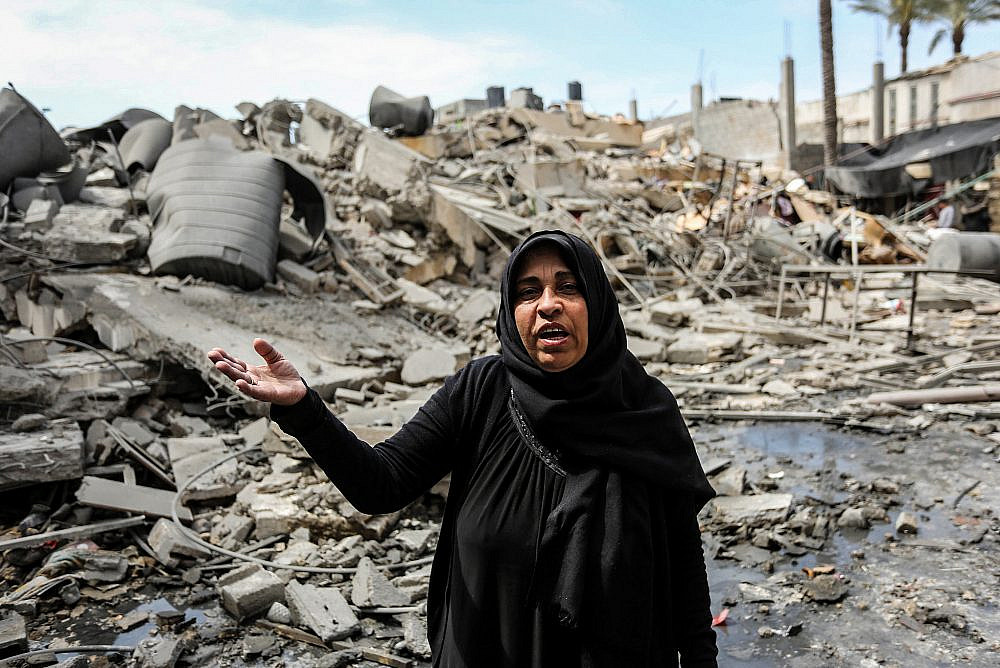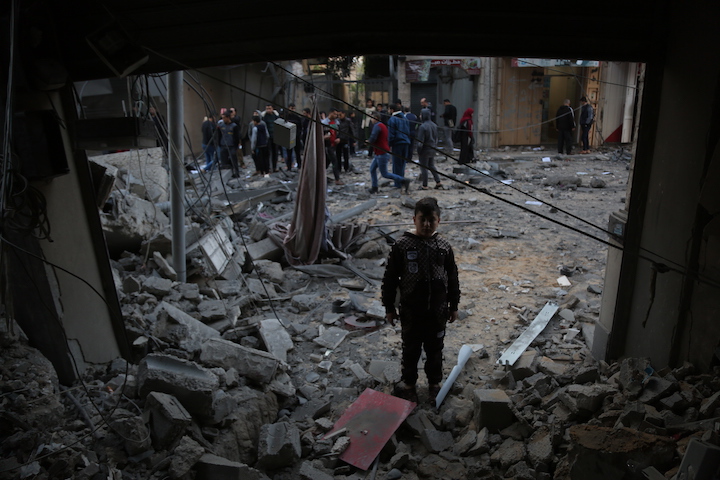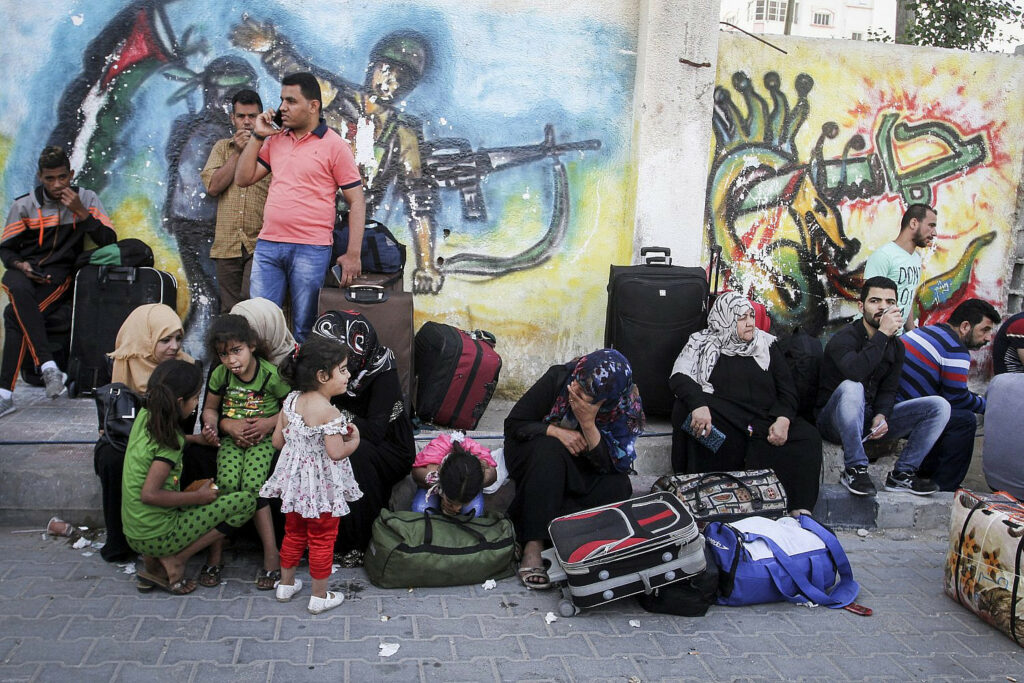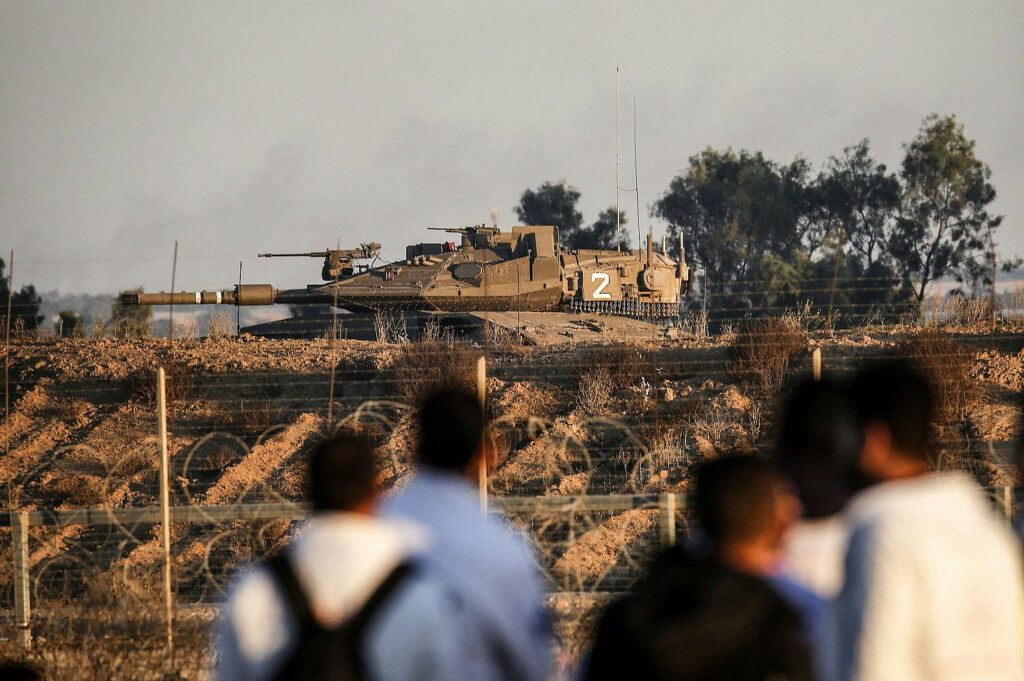The UN Predicted Gaza Would Be Unlivable by 2020. They Were Right.
PALESTINE ISRAEL GAZA GENOCIDE, 6 Jan 2020
Tania Hary | +972 Magazine – TRANSCEND Media Service
31 Dec 2019 – Israel is trying to keep Gaza ‘quiet’ by applying new calculations to make life survivable — without allowing the people to truly live.

View of a destroyed house after Israeli air strikes targeted a nearby Hamas site on Monday, in Gaza City, on March 26, 2019. (Abed Rahim Khatib/ Flash90)
While revelers around the world are making New Year’s resolutions for 2020, in the Gaza Strip, a different kind of assessment is taking place as Palestinians try to determine whether, or how, they can survive the next 10 years. In 2012, the United Nations published a report whose title asked a jarring question: “Gaza in 2020: A Liveable Place?” The report surmised that without fundamental change and collective effort, the strip would become “unlivable” in only eight years’ time.
The report was released just months before the second of three Israeli military operations that would be launched in Gaza over a period of six years. Following the third operation, Protective Edge, in 2014, with its massive toll in human life and extensive damage to civilian infrastructure, UN officials subsequently warned that the strip would actually become unlivable by 2018. The predictions of the Gaza 2020 report had not factored in military operations of such magnitude.
Nonetheless, on the eve of 2020, people are asking what became of the UN’s predictions – as if at the stroke of midnight, the specter of unlivebility may or may not come true. Yet by all accounts, and according to the indicators chosen by the UN, life in Gaza is palpably worse now than it was in 2012. For example, the unemployment rate went from 29% when the report was written to 45% today, with the rate at more than 60% among young Palestinians.
Dishearteningly, the capacity for electricity production in the strip has remained unchanged over the past eight years, despite increased demand as the population grew from 1.6 million to nearly two million. Electricity supply even got worse given that Egyptian lines have been out of operation since early 2018. Power is available for just half the day – an improvement over certain periods, but nowhere near reasonable for 2020. Aquifer water is 96% undrinkable, as predicted. Households spend precious income on purchasing drinking water, which is not always safe; and given that many families cannot afford to purchase water, water-borne illnesses, especially among children, are widespread.

Palestinians in Gaza look on at the remains of the Yaziji building in Gaza City, following air strikes by the Israeli Air Force. Yaziji served as both a residential and commercial building, and was home to around 40 families, November 13, 2018. (Mohammad Zaanoun/Activestills.org)
Israel, through its control over movement, has played a central and intentional role in this decline. Israeli citizens are told that it’s “all Hamas’s fault,” which may help them to sleep better at night, but belies the truth of the story. Gaza has been gradually cut off and isolated by Israel over decades; and in 2007, when Hamas took power in the strip, Israel all but hermetically sealed off the territory.
Israeli officials made a calculus – quite literally – that applying pressure would help it achieve its political goals in Gaza. At points, Israel limited entrance of food and, for the past 12 years, has targeted sectors of the economy with policies like arbitrary limits on fishing and access to farmlands, on entrance of inputs for manufacturing, and on marketing and export of goods. Several military operations later, though, some Israeli officials acknowledged that their “calculus” was way off. Particularly following Protective Edge, many noted that the deteriorating humanitarian situation on the ground was actually a liability for Israel.
The army’s head of intelligence even cited the UN’s Gaza 2020 report in a Knesset Committee hearing in early 2016, telling Knesset members that economic activity was needed to head off the UN’s prediction that the strip would become unlivable by 2020. He called economic activity “the most important restraining factor” and said that without an improvement in conditions on the ground, Israel would be the first to experience the blowback. This type of logic became common among Israeli officials, from the defense ministry to the prime minister himself, even though these individuals had actively overseen policies that were designed to do the exact opposite.
This logic translated into meager policy changes. In 2012, the fishing limit was just three nautical miles from the shore, then rose to six miles in 2015, then to 15 miles in some parts today. Unlike in 2012, when no goods were permitted to exit Gaza to be sold in its traditional markets in the West Bank and Israel, today an array of goods can go to the West Bank and some products can also be sold in Israel. In 2012, an average of just 22 truckloads of goods exited Gaza, while in 2019 it was more than 10 times that amount, or 240 truckloads monthly. In 2012, construction materials were barely allowed in for international organizations, while today, materials can enter for the private sector under the Gaza Reconstruction Mechanism.

Palestinians wait at the Rafah border crossing with Egypt, in the southern Gaza Strip, after it was opened for two days by Egyptian authorities, on May 11, 2016. (Abed Rahim Khatib/ Flash90)
However, while these micro changes gave some relief to Palestinians in Gaza, they have not reversed the strip’s macro deterioration. Rather than attempting to transform the situation, Israel and other regional actors are simply searching for a new calculus to achieve “quiet” by making Gaza more survivable.
In line with this objective, Egypt began regularly operating the Rafah Crossing with Gaza in 2018, after keeping it mostly closed for five years. Qatar also stepped forward with massive financial support in 2018 and 2019, paying for fuel for electricity generation at the strip’s only power plant, supporting construction projects, and giving cash payments to poor families. Other donors – European countries, Gulf states, and others – continued substantial funding to UNRWA and to dozens of other international and local organizations, providing critical aid and bridging gaps caused by cuts in U.S. funding.
Is this the massive effort that the UN envisaged was needed to change course and make Gaza livable? Far from it. It is the bare minimum required to keep people’s heads just above water, absent of real economic development, prospects for future growth, or a commitment to human rights.
The Israeli policy changes, the increase in truckloads, and the aid money have all gone to keeping things just good enough so as not to allow a massive outbreak of disease, and to calm a potential uprising by those thirsty for water. No one should be breathing a sigh of relief, however, as the “quiet” cannot erase the hunger felt by thousands of Palestinian families suffering food insecurity. And it does not mask the desperation of young men who are fleeing the strip in search of a better life.

Palestinian demonstrators clash with Israeli security forces during a protest along the border with Israel, in the eastern part of the Gaza Strip, December 20, 2019.
(Fadi Fahd/Flash90)
It is an illusion to think that this situation is manageable. No one should be sleeping soundly at night until there is a significant shift in approach, whereby civilians are not held hostage to the actions of their de facto government, and are not turned into fodder for the election campaigns of failing Israeli politicians. There have been substantive efforts by the international community and even some policy changes from Israel, but there has never been a fundamental decision on the part of Israel to actually let people live in Gaza, rather than just survive.
Human beings are not machines, and many of the indicators that make life worth living cannot be found in a UN report. Yes, people need water, electricity, jobs, and healthcare to get by – but what about the things that are harder to measure? The need for freedom, the ability to plan one’s life, to feel hopeful about the prospects for one’s children, and to feel safe in one’s home?
In that sense, the Gaza 2020 report and Israeli officials who tried to follow its prescriptions fell very short. But the UN officials who warned that Gaza would become unlivable by 2018 were onto something. In 2018, the floodgates of hopelessness in Gaza were pried open as people realized that the plan is to preserve their isolation with no prospect of a resolution to the conflict. Through their protests at the Great March of Return, young Palestinians in Gaza, the vast majority of the population, showed the world that it is not just food and water that they need to survive. They need freedom, dignity and hope.
____________________________________________
Tania Hary is the executive director of Gisha, an Israeli NGO founded in 2005, whose goal is to protect the freedom of movement of Palestinians, especially Gaza residents.
Tags: Conflict, Fatah, Gaza, Geopolitics, Hamas, Human Rights, Israel, Nakba, Oslo Accords, Palestine, Palestine/Israel, Politics, Power, Settlers, Social justice, State Terrorism, UN, USA, Violence, West Bank, Zionism
Join the BDS-BOYCOTT, DIVESTMENT, SANCTIONS campaign to protest the Israeli barbaric siege of Gaza, illegal occupation of the Palestine nation’s territory, the apartheid wall, its inhuman and degrading treatment of the Palestinian people, and the more than 7,000 Palestinian men, women, elderly and children arbitrarily locked up in Israeli prisons.
DON’T BUY PRODUCTS WHOSE BARCODE STARTS WITH 729, which indicates that it is produced in Israel. DO YOUR PART! MAKE A DIFFERENCE!
7 2 9: BOYCOTT FOR JUSTICE!
DISCLAIMER: The statements, views and opinions expressed in pieces republished here are solely those of the authors and do not necessarily represent those of TMS. In accordance with title 17 U.S.C. section 107, this material is distributed without profit to those who have expressed a prior interest in receiving the included information for research and educational purposes. TMS has no affiliation whatsoever with the originator of this article nor is TMS endorsed or sponsored by the originator. “GO TO ORIGINAL” links are provided as a convenience to our readers and allow for verification of authenticity. However, as originating pages are often updated by their originating host sites, the versions posted may not match the versions our readers view when clicking the “GO TO ORIGINAL” links. This site contains copyrighted material the use of which has not always been specifically authorized by the copyright owner. We are making such material available in our efforts to advance understanding of environmental, political, human rights, economic, democracy, scientific, and social justice issues, etc. We believe this constitutes a ‘fair use’ of any such copyrighted material as provided for in section 107 of the US Copyright Law. In accordance with Title 17 U.S.C. Section 107, the material on this site is distributed without profit to those who have expressed a prior interest in receiving the included information for research and educational purposes. For more information go to: http://www.law.cornell.edu/uscode/17/107.shtml. If you wish to use copyrighted material from this site for purposes of your own that go beyond ‘fair use’, you must obtain permission from the copyright owner.
Read more
Click here to go to the current weekly digest or pick another article:
PALESTINE ISRAEL GAZA GENOCIDE: